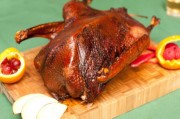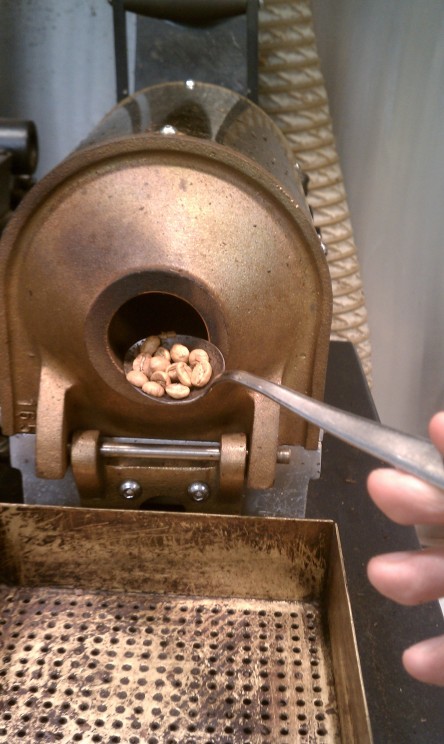
With Christmas approaching, we are looking towards the food we’ll share on the day itself. If you’re looking for ideas, who better to consult that Mrs Isabella Beeton herself, who authored the seminal Household Management at just 22 years old. Below is her sage advice on that classic Christmas meat, roast goose.
Ingredients:
Goose
4 large onions
10 sage-leaves
¼ lb. of bread crumbs
1 ½ oz. of butter
salt and pepper to taste
1 egg
Choosing and Trussing
Select a goose with a clean white skin, plump breast, and yellow feet: if these latter are red, the bird is old. Should the weather permit, let it hang for a few days: by so doing, the flavour will be very much improved. Pluck, singe, draw, and carefully wash and wipe the goose; cut off the neck close to the back, leaving the skin long enough to turn over; cut off the feet at the first joint, and separate the pinions at the first joint. Beat the breast-bone flat with a rolling-pin, put a skewer though the under part of each wing, and having drawn up the legs closely, put a skewer into the middle of each, and pass the same quite through the body. Insert another skewer into the small of the leg, bring it close down to the side bone, run it through, and do the same to the other side. Now cut off the end of the vent, and make a hole in the skin sufficiently large for the passage of the rump, in order to keep in the seasoning.
Mode
Make a sage-and-onion stuffing of the above ingredients; put it into the body of the goose, and secure it firmly at both ends, by passing the rump through the hole made in the skin, and  the other end by tying the skin of the neck to the back; by this means the seasoning will not escape. Put it down to a brisk fire, keep it well basted, and roast from 1 ½ to 2 hours, according to the size. Remove the skewers, and serve with a tureen of good gravy, and one of well-made apple-sauce. Should a very highly-flavoured seasoning be preferred, the onions should not be parboiled, but minced raw: of the two methods, the mild seasoning in far superior. A ragout, or pie, should be made of the giblets, or they may be stewed down to make gravy. Be careful to serve the goose before the breast falls, or its appearance will be spoiled by coming flattened to the table. As this is rather a troublesome joint to carve, a large quantity of gravy should not be poured round the goose, but sent in a tureen.
the other end by tying the skin of the neck to the back; by this means the seasoning will not escape. Put it down to a brisk fire, keep it well basted, and roast from 1 ½ to 2 hours, according to the size. Remove the skewers, and serve with a tureen of good gravy, and one of well-made apple-sauce. Should a very highly-flavoured seasoning be preferred, the onions should not be parboiled, but minced raw: of the two methods, the mild seasoning in far superior. A ragout, or pie, should be made of the giblets, or they may be stewed down to make gravy. Be careful to serve the goose before the breast falls, or its appearance will be spoiled by coming flattened to the table. As this is rather a troublesome joint to carve, a large quantity of gravy should not be poured round the goose, but sent in a tureen.
Time – A large goose, 1 ¾ hour; a moderate-sized one, 1 ¼ hour to 1 ½ hour.
Seasonable from September to March; but in perfection from Michaelmas to Christmas.
Average cost, 5s. 6d. each. Sufficient for 8 or 9 persons.
Note
A teaspoon of made mustard, a saltspoonful of salt, a few grains of cayenne, mixed with a glass of port wine, are sometimes poured into the goose by a slit made in the apron. This sauce is, by many persons, considered an improvement.
Mrs Beeton’s Book of Household Management is a founding text of Victorian middle-class identity. It offers highly authoritative advice on subjects as diverse as fashion, child-care, animal husbandry, poisons, and the management of servants. The Oxford World’s Classics edition is an abridged version, edited by Nicola Humble, which does justice to its high status as a cookery book, while also suggesting ways of approaching this massive, hybrid text as a significant document of social and cultural history.
For over 100 years Oxford World’s Classics has made available the broadest spectrum of literature from around the globe. Each affordable volume reflects Oxford’s commitment to scholarship, providing the most accurate text plus a wealth of other valuable features, including expert introductions by leading authorities, voluminous notes to clarify the text, up-to-date bibliographies for further study, and much more.
Subscribe to the OUPblog via email or RSS.
Subscribe to only literature articles on the OUPblog via email or RSS.
Image credit: Crispy grilled goose for Christmas. Photo by Chikei Yung, iStockphoto.
The post Roast Goose, the Mrs Beeton way appeared first on OUPblog.



